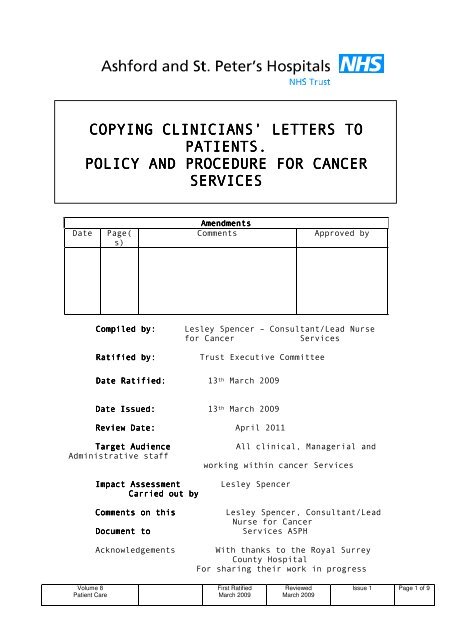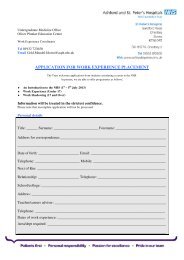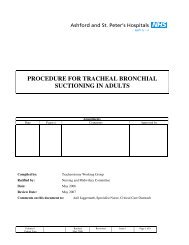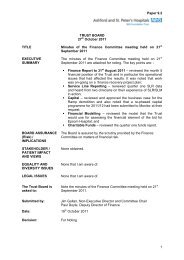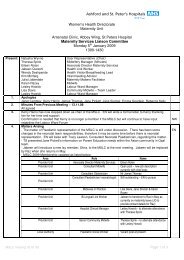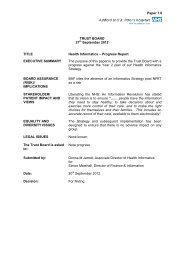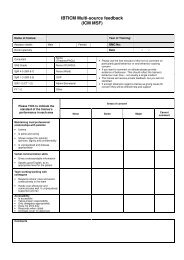Copying patients into clinical letters - Ashford and St. Peter's ...
Copying patients into clinical letters - Ashford and St. Peter's ...
Copying patients into clinical letters - Ashford and St. Peter's ...
Create successful ePaper yourself
Turn your PDF publications into a flip-book with our unique Google optimized e-Paper software.
COPYING COPYING CLINICIANS<br />
CLINICIANS’ CLINICIANS LETTERS LETTERS TO<br />
TO<br />
PATIENTS PATIENTS.<br />
PATIENTS<br />
POLICY POLICY AND AND PROCEDURE PROCEDURE FOR FOR CANCER<br />
CANCER<br />
SERVICES SERVICES<br />
SERVICES<br />
Date Page(<br />
s)<br />
Volume 8<br />
Patient Care<br />
Amendments<br />
Amendments<br />
Comments Approved by<br />
Compiled Compiled by: by: Lesley Spencer – Consultant/Lead Nurse<br />
for Cancer Services<br />
Ratified Ratified Ratified by:<br />
by:<br />
Date Date Ratified Ratified:<br />
Ratified :<br />
Date Date Issued:<br />
Issued:<br />
Review Review Date:<br />
Date:<br />
Target Target Audience<br />
Audience<br />
Administrative staff<br />
Impact Impact Assessment<br />
Assessment<br />
Assessment<br />
CCarried<br />
C arried out out by<br />
by<br />
Comments Comments Comments on on this<br />
this<br />
Document ocument to<br />
to<br />
Trust Executive Committee<br />
13 th March 2009<br />
13 th March 2009<br />
First Ratified<br />
March 2009<br />
April 2011<br />
All <strong>clinical</strong>, Managerial <strong>and</strong><br />
working within cancer Services<br />
Lesley Spencer<br />
Lesley Spencer, Consultant/Lead<br />
Nurse for Cancer<br />
Services ASPH<br />
Acknowledgements With thanks to the Royal Surrey<br />
County Hospital<br />
For sharing their work in progress<br />
Reviewed<br />
March 2009<br />
Issue 1 Page 1 of 9
INTRODUCTION<br />
INTRODUCTION<br />
Volume 8<br />
Patient Care<br />
ASHFORD ASHFORD & & & ST. ST. ST. PETER’S PETER’S HOSPITAL HOSPITAL NHS NHS NHS TRUST<br />
TRUST<br />
COPYING COPYING CLINICIANS’ CLINICIANS’ LETTERS LETTERS TO TO PATIENTS<br />
PATIENTS<br />
POLICY POLICY AND AND PROCEDURE PROCEDURE PROCEDURE FOR FOR CANCER CANCER SERVICES<br />
SERVICES<br />
The The Introduction Introduction of of a a National National National Policy<br />
Policy<br />
Following an NHS plan commitment, work by the Department of<br />
Health (DOH) <strong>and</strong> the publication of Good Practice Guidelines<br />
by the DOH the practice of making available to <strong>patients</strong> copies<br />
of clinician’s <strong>letters</strong> became national policy on 1 st April 2004<br />
It is now regularly mentioned in DOH publications, the Cancer<br />
Reform <strong>St</strong>rategy <strong>and</strong> National Peer Review although it has been<br />
left to individual Trusts to decide how to implement <strong>and</strong><br />
publicize this policy.<br />
PURPOSE<br />
PURPOSE<br />
The Purpose of this policy is to provide a clear <strong>and</strong> safe<br />
procedure for <strong>clinical</strong> <strong>and</strong> administrative staff to follow in<br />
order to comply with National Guidelines, Peer review <strong>and</strong><br />
adhere to the principles of best practice.<br />
THE THE TERMS ERMS OF OF THE THE NATIONAL NATIONAL POLICY<br />
POLICY<br />
The National Policy proposes that – where <strong>patients</strong> agree,<br />
<strong>letters</strong> written by one health care professional to another<br />
about a patient should be copied to the patient (or where<br />
appropriate their parent or guardian).The general principle is<br />
that it is the <strong>patients</strong> right to be copied <strong>into</strong> all <strong>letters</strong><br />
that help to improve their underst<strong>and</strong>ing of the health care<br />
they are receiving.<br />
In terms of the National Policy a ‘letter’ includes<br />
communication between different health care professionals –<br />
including GP’s, hospital doctors, nurses <strong>and</strong> therapists, <strong>and</strong><br />
may include <strong>letters</strong>, forms of referral <strong>and</strong> discharge<br />
summaries.<br />
.<br />
Raw data such as blood results should not be copied until it<br />
can be put <strong>into</strong> an appropriate context/explanation.<br />
First Ratified<br />
March 2009<br />
Reviewed<br />
March 2009<br />
Issue 1 Page 2 of 9
FREQUENCY<br />
FREQUENCY<br />
Where there is frequent communication, the person responsible<br />
for writing the letter should consider if it would be useful<br />
for the patient to have a copy every time.<br />
NO NO SURPRISES<br />
SURPRISES<br />
Where the letter contains abnormal results or significant<br />
information that has not been discussed with the patient, it<br />
will be important for arrangements to be made to give the<br />
patient a copy of the letter after its contents have been<br />
discussed in a consultation with the professional. As a<br />
general rule the contents of copied <strong>letters</strong> should reflect the<br />
discussion in the consultation with the sending healthcare<br />
professional, <strong>and</strong> there should be no new information in the<br />
letter that might surprise or distress the patient.<br />
WHEN WHEN LETTERS LETTERS SHOULD SHOULD NOT NOT NOT BE BE BE COPIED<br />
COPIED<br />
There may be reasons why the general policy of copying <strong>letters</strong><br />
to <strong>patients</strong> should not be followed. These include:<br />
Volume 8<br />
Patient Care<br />
Where the patient does not want a copy<br />
Where the clinician feels that it may cause harm to the<br />
patient<br />
Where the letter includes information about a third party<br />
who has not given consent<br />
HARM HARM TO TO THE THE PATIENT<br />
PATIENT<br />
Giving of "bad news" is not in itself enough to justify not<br />
copying a letter. The pilot studies showed that it is<br />
sometimes the case that health professionals are anxious to<br />
protect <strong>patients</strong>, who themselves often wish to have as much<br />
information as possible, even if it may be ‘bad news’ or<br />
uncertainty.<br />
CONSENT<br />
CONSENT<br />
The copying <strong>letters</strong> policy is underpinned by a presumption of<br />
the patient's informed consent to the receipt of any letter.<br />
The aim is that within a consultation, the possibility of<br />
receipt of the letter should be raised as part of the wider<br />
discussion about 'what will happen next'. In other words,<br />
<strong>patients</strong> should routinely be asked during a consultation<br />
whether they want a copy of any letter written as a result of<br />
that consultation <strong>and</strong> any related tests or interventions.<br />
Agreement from the patient to receive copies of <strong>letters</strong> would<br />
be seen as consent.<br />
The circumstances of <strong>letters</strong> about an individual patient will<br />
vary. It might be sufficient to seek consent once rather than<br />
each time a letter is written. This is as long as it is<br />
explained at the start of an episode that copies of <strong>letters</strong><br />
will be sent routinely to the patient or responsible person<br />
unless the patient decides to opt out of receiving copies of<br />
First Ratified<br />
March 2009<br />
Reviewed<br />
March 2009<br />
Issue 1 Page 3 of 9
<strong>letters</strong>, which can be done at any time. Good practice<br />
suggests, however, that the patient be reminded each time a<br />
letter is to be copied.<br />
ISSUES ISSUES TO TO TO BE BE CONSIDE CONSIDERED<br />
CONSIDE RED<br />
Use of plain English to improve readability<br />
Volume 8<br />
Patient Care<br />
Setting out the facts <strong>and</strong> avoiding unnecessary<br />
speculation<br />
Reinforcing <strong>and</strong> confirming the information given in<br />
discussion with the patient in the consultation.<br />
Some healthcare professionals prefer to write <strong>letters</strong><br />
directly to <strong>patients</strong>, with a copy to the general<br />
practitioner or other healthcare professionals. Evidence<br />
shows that <strong>patients</strong> appreciate such practices, which give<br />
the clinician the option of adding additional information<br />
<strong>and</strong> advice about life style <strong>and</strong> management of the illness<br />
or condition.<br />
Patients should be able to say where they would like to<br />
receive a copied letter <strong>and</strong> in what format. People with<br />
special communication or language needs should be able to<br />
specify how they would like to receive information. This<br />
should be recorded in an appropriate way.<br />
OPTIONS OPTIONS FOR FOR FOR PROVIDIN PROVIDING PROVIDIN G COPIES COPIES OF OF LETTERS LETTERS INCLUDE:<br />
INCLUDE:<br />
A printed copy of the letter<br />
Copies in large print, or in some other format, such as<br />
on audio - tape<br />
Viewing <strong>letters</strong> on screen in the hospital or practice<br />
Sending by post or collection from an appropriate place,<br />
where there are concerns about privacy at home<br />
Copies of <strong>letters</strong> dictated in the presence of the<br />
patient.<br />
CONFID CONFIDENTIALITY<br />
CONFID CONFIDENTIALITY<br />
ENTIALITY<br />
Procedures should minimize the likelihood of information being<br />
accessed by unauthorized people <strong>and</strong> ensure <strong>patients</strong> who choose<br />
to have information posted or e-mailed are aware of the risks<br />
such procedures might entail. Envelopes should be marked<br />
‘confidential’ <strong>and</strong> <strong>patients</strong>’ addresses routinely checked.<br />
Patients’ full names, rather than initials, should be used as<br />
a matter of good practice. It should also be a matter of good<br />
practice to check whether two people with the same name live<br />
at one address.<br />
ASHFORD ASHFORD AND AND ST ST ST PETER PETERS PETER PETERS<br />
S NHS NHS TRUST’S TRUST’S POLICY<br />
POLICY<br />
First Ratified<br />
March 2009<br />
Reviewed<br />
March 2009<br />
Issue 1 Page 4 of 9
IMPLEMENTATION<br />
Cancer Services supported by the Cancer Board proposes to<br />
implement the National Policy across all the various tumour<br />
groups. Initially this initiative will be publicised to<br />
<strong>patients</strong> across the departments. From January 2009 all cancer<br />
<strong>patients</strong> will be offered a copy of their consultations from<br />
diagnosis onwards unless they have decided to opt out or there<br />
is a reason as outlined above not to copy a letter to a<br />
patient.<br />
REFUSAL OF A REQUEST/WITHHOLDING A LETTER<br />
If the health care professional should refuse a request for a<br />
copy of the letter or should decide to withhold one, the<br />
reason for the decision should be recorded in the patient’s<br />
notes.<br />
DISCLAIMER CONCERNING TECHNICAL INFORMATION<br />
Any <strong>letters</strong> copied to <strong>patients</strong> should contain a disclaimer<br />
advising that as it is a <strong>clinical</strong> letter it may contain<br />
technical terms, <strong>and</strong> advise <strong>patients</strong> how they can receive<br />
further explanation if required.<br />
LINK WITH ACCESS TO MEDICAL RECORDS<br />
This policy is not intended to retrospectively apply to<br />
<strong>letters</strong> written before Jan 2009<br />
The Trust Policy <strong>and</strong> Procedure in respect of patient access to<br />
medical records remains unchanged <strong>and</strong> should be drawn to the<br />
attention of any patient seeking retrospective access to<br />
correspondence, or wider access to their medical records.<br />
ARCHIVING ARCHIVING ARCHIVING ARRANGEMEN<br />
ARRANGEMENTS<br />
ARRANGEMEN<br />
ARRANGEMENTS<br />
TS<br />
This is a Cancer Services policy. As Cancer <strong>patients</strong> are<br />
treated in all departments throughout the Trust the archiving<br />
arrangements are managed by the quality department who can be<br />
contacted to request master or archived copies.<br />
EQUALITY EQUALITY IMPACT IMPACT ASSE ASSESSMENT<br />
ASSE ASSESSMENT<br />
SSMENT<br />
See Appendix 1.<br />
REFERENCES<br />
REFERENCES<br />
<strong>Copying</strong> <strong>letters</strong> to <strong>patients</strong>: good practice guidelines<br />
Department of Health 30 April 2003<br />
<strong>Copying</strong> Letters to Non English Speakers Silkapp Consultants<br />
1995<br />
Volume 8<br />
Patient Care<br />
First Ratified<br />
March 2009<br />
Reviewed<br />
March 2009<br />
Issue 1 Page 5 of 9
<strong>Copying</strong> <strong>letters</strong> to <strong>patients</strong>: a report to the Department of<br />
Health <strong>and</strong> draft good practice guidelines for consultation<br />
Department of Health 18 April 2002<br />
Advanced Communication Skills Training H<strong>and</strong>out for Senior<br />
Healthcare professionals working in cancer care National<br />
Cancer Action team 2007<br />
Volume 8<br />
Patient Care<br />
First Ratified<br />
March 2009<br />
Reviewed<br />
March 2009<br />
Issue 1 Page 6 of 9
Volume 8<br />
Patient Care<br />
EQUALITY EQUALITY IMPACT IMPACT ASSE ASSESSMENT ASSE SSMENT TOOL<br />
TOOL<br />
First Ratified<br />
March 2009<br />
Reviewed<br />
March 2009<br />
APPENDIX APPENDIX 1<br />
1<br />
To be completed <strong>and</strong> attached to any policy when submitted to<br />
the appropriate committee for consideration <strong>and</strong> approval.<br />
1.<br />
Does Does Does the the policy policy/guidance policy policy /guidance affect<br />
affect<br />
one one one group group less less or or or more more<br />
more<br />
favourably favourably than than than another another on on the<br />
the<br />
basis basis of:<br />
of:<br />
Race <strong>and</strong> Ethnic origin<br />
(include gypsies <strong>and</strong><br />
travellers) (consider<br />
communication, access to<br />
information on services <strong>and</strong><br />
employment, <strong>and</strong> ease of access<br />
to services <strong>and</strong> employment)<br />
Disability (consider<br />
communication issues, access to<br />
employment <strong>and</strong> services,<br />
whether individual care needs<br />
are being met <strong>and</strong> whether the<br />
policy promotes the involvement<br />
of disabled people)<br />
Yes/No Yes/No<br />
Comments Comments<br />
Comments<br />
For each category<br />
describe how you<br />
have involved<br />
stakeholders<br />
including service<br />
users <strong>and</strong> employees<br />
Yes The draft of this<br />
policy has been<br />
approved by the<br />
Cancer board. The<br />
patient<br />
representative on<br />
the board was<br />
specifically asked<br />
to comment on the<br />
policy <strong>and</strong> the value<br />
that this may have<br />
for Cancer <strong>patients</strong>.<br />
It is recognised<br />
that <strong>patients</strong> whose<br />
first language is<br />
not English may have<br />
difficulty reading<br />
<strong>and</strong> interpreting<br />
this policy.<br />
Clinical staff need<br />
therefore to go<br />
through the policy<br />
with the individual<br />
or employ a<br />
translator as<br />
necessary. The<br />
<strong>Copying</strong> <strong>letters</strong> to<br />
Non English Speakers<br />
document is<br />
referenced<br />
This policy may<br />
impact on those<br />
individuals who are<br />
hearing or sight<br />
impaired. Clinical<br />
teams may need to<br />
either produce<br />
Issue 1 Page 7 of 9
Volume 8<br />
Patient Care<br />
Gender (consider care needs <strong>and</strong><br />
employment issues, identify <strong>and</strong><br />
remove or justify terms which<br />
are gender specific)<br />
Culture (consider dietary<br />
requirements <strong>and</strong> individual<br />
care needs)<br />
Religion or belief (include<br />
dress, individual care needs<br />
<strong>and</strong> spiritual needs for<br />
consideration)<br />
Sexual orientation including<br />
lesbian, gay <strong>and</strong> bisexual<br />
people (consider whether the<br />
policy/service promotes a<br />
culture of openness <strong>and</strong> takes<br />
account of individual needs<br />
Age (consider any barriers to<br />
accessing services or<br />
employment, identify <strong>and</strong> remove<br />
or justify terms which could be<br />
ageist)<br />
2. Is Is there there any any evidence evidence that that some<br />
some<br />
groups groups are are affected affected<br />
affected<br />
differently?<br />
differently?<br />
3. If If you you have have identified<br />
identified<br />
potential potential discrimination, discrimination, for<br />
for<br />
example, example, less less than than equal<br />
equal<br />
access, access, access, are are are any any any exceptions<br />
exceptions<br />
exceptions<br />
valid, valid, legal legal <strong>and</strong>/or<br />
<strong>and</strong>/or<br />
justifiable, justifiable, justifiable, for for for example example a<br />
a<br />
genuine genuine occupational<br />
occupational<br />
First Ratified<br />
March 2009<br />
Yes/No Yes/No<br />
Comments Comments<br />
Comments<br />
Reviewed<br />
March 2009<br />
information in a way<br />
that can be<br />
understood by the<br />
patient e.g. large<br />
print or provide a<br />
translator if<br />
required<br />
No impact<br />
No Impact<br />
It is recognised<br />
that <strong>patients</strong> whose<br />
first language is<br />
not English may have<br />
difficulty reading<br />
<strong>and</strong> interpreting<br />
this policy.<br />
Clinical staff need<br />
therefore to go<br />
through the policy<br />
with the individual<br />
or employ a<br />
translator as<br />
necessary<br />
No impact<br />
No Impact<br />
Yes<br />
No<br />
Issue 1 Page 8 of 9
Volume 8<br />
Patient Care<br />
qualification?<br />
qualification?<br />
4. 4. Is Is the the impact impact of of of the<br />
the<br />
policy/guidance policy/guidance likely likely to to to be be<br />
be<br />
negative?<br />
negative?<br />
negative?<br />
5. 5. If If so so so can can the the impact impact be<br />
be<br />
avoided?<br />
avoided?<br />
6. Wha What Wha t alternatives alternatives are are there there to<br />
to<br />
achieving achieving the the the policy/guidance<br />
policy/guidance<br />
without without the the impact?<br />
impact?<br />
First Ratified<br />
March 2009<br />
Yes/No Yes/No<br />
Comments Comments<br />
Comments<br />
7. Can Can we we reduce reduce the the impact impact by<br />
by<br />
Detailed above<br />
taking taking different different action?<br />
action?<br />
If you have identified a potential discriminatory impact of<br />
this policy, please refer it to the appropriate Action Group,<br />
together with any suggestions as to the action required to<br />
avoid/reduce this impact.<br />
For advice in respect of answering the above questions, please<br />
contact Maria Crosbie, HR Manager, on extension 2552.<br />
No<br />
N/A<br />
N/A<br />
Reviewed<br />
March 2009<br />
Issue 1 Page 9 of 9


